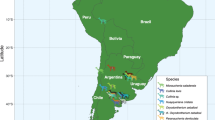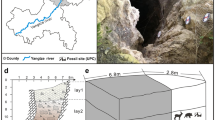Abstract
An almost complete calvaria of an adult macaque was found among remain from the Shikimizu limestone quarry at Hijikawa-cho, Kita-gun, Ehime Pref., Shikoku, Japan. Its exact age is unknown, but probably Pleistocene because mammalian bones from this quarry include not only recent but some Pleistocene elements. The Shikimizu skull has a somewhat different feature as compared with the skull of livingMacaca fuscata, mainly in that its facial region is much broader. In this feature, the Shikimizu skull seems to somewhat resembleMacaca robustus from China, suggesting that the older the lineage offuscata is traced back in the Pleistocene, the more its ancestral type would becomerobustus-like in the morphology.
Similar content being viewed by others
References
Delson, E., 1973.Fossil Colobine Monkeys of the Circum-Mediterranean Region and the Evolutionary History of the Cercopithecidae (Primates, Mammalia). University Microfilms, Ann Arbor, 856pp.
Fooden, J., 1969. Taxonomy and Evolution of the Monkeys of Celebes (Primates: Cercopithecidae),Bibliotheca Primatologica, No. 10, S. Karger, Basel, 148pp.
————, 1971. Male external genitalia and systematic relationships of the Japanese macaque (Macaca fuscata Blyth, 1875).Primates, 12: 305–311.
Hasegawa, Y., 1966. Quaternary smaller mammalian fauna from Japan.Fossils, 11: 31–40. (in Japanese)
Ikeda, J. &T. Watanabe, 1966. Morphological studies ofMacaca fuscata. III. Craniometry.Primates, 7: 271–288.
Iwamoto, M. &Y. Hasegawa, 1972a. Two macaque fossil teeth from the Japanese Pleistocene.Primates, 13: 77–81.
———— &F. Takai, 1972b. The Pleistocene macaque from the Tokai district, Japan.J. Anthrop. Soc. Nippon, 80: 1–10. (in Japanese)
Martin, R. & K. Saller, 1957.Lehrbuch der Anthropologie, Bd. I, Gustav Fischer, Stuttgart, 661 Seiten.
Pei, W. C., 1936. On the mammalian remains from Locality 3 at Choukoutien.Palaeontologia Sinica, Ser. C, Vol. VII, Fasc. 5, Peiping, 120 pp. with 6 plates and Chinese summary.
Saheki, M., 1966. Morphological studies ofMacaca fuscata. IV. Dentition.Primates, 7: 407–422.
Schlosser, 1924. Fossil primates from China.Palaeontologia sinica, Ser. C, Vol. I, Fasc. 2, pp. 14 with a plate and Chinese summary.
Shikama, T., 1949. The Kuzuü ossuaríes; geological and palaeontological studies of the limestone fissure deposits, in Kuzuü, Tochigi Prefecture.Sci. Report Tohoku Univ., 2nd ser. (Geol.), Vol. 23, 201 pp. with 32 plates.
————, &Y. Hasegawa, 1962. Discovery of the fossil giant salamander (Megalobatrachus) in Japan.Trans. Proc. Palaeont. Soc. Japan, N. S., 45: 197–200.
Young, C. C., 1934. On the Insectivora, Chiroptera, Rodentia and Primates other than Sinanthropus from locality 1 at Choukoutien.Palaeontologia Sinica, Ser. C, Vol. VIII, Fasc. 3, Peiping, 139 pp. with 10 plates and Chinese summary.
Author information
Authors and Affiliations
About this article
Cite this article
Iwamoto, M. On a skull of a fossil macaque from the shikimizu limestone quarry in the Shikoku district, Japan. Primates 16, 83–94 (1975). https://doi.org/10.1007/BF02381801
Received:
Accepted:
Issue Date:
DOI: https://doi.org/10.1007/BF02381801




